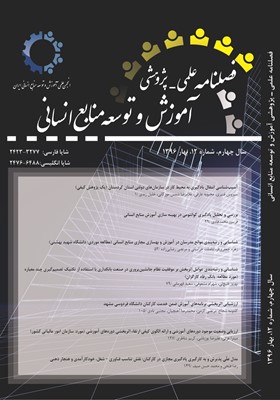شناسائی و رتبهبندی عوامل اثربخش بر موفقیت نظام جانشینپروری در صنعت بانکداری با استفاده از تکنیک تصمیمگیری چند معیاره (مورد مطالعه: بانک رفاه کارگران)
محورهای موضوعی :بهروز قلیچ لی 1 , شهرام مشعوفی 2 , سعید قهرمانی 3 *
1 - دانشکده مدیریت و حسابداری
2 - دانشگاه آزاد اسلامی
3 - دانشگاه علامه طباطبایی
کلید واژه: نظام جانشینپروری, عوامل کلیدی موفقیت, کانون ارزیابی و توسعه, تاپسیس فازی,
چکیده مقاله :
پژوهش حاضر با هدف شناسائی و رتبهبندی عوامل اثربخش بر موفقیت نظام جانشینپروری در صنعت بانکداری انجام گرفته است که با توجه به هدف، کاربردی و از نظر شیوه های اجرا، توصیفی است و از بین مدیران و کارشناسان خبره بانک رفاه، تعداد 15 نفر به عنوان نمونه آماری انتخاب شدند. نمونهگیری از طریق مراجعه به آراء خبرگان انجام و نظرات خبرگان به روش دلفی جمعآوری گردید. ابزار گردآوری داده ها، پرسشنامه محقق ساخته عوامل اثربخش بر موفقیت جانشینپروری بود که داده های آماری با استفاده از نرم افزارهای Spss و Excel مورد تجزيه و تحليل قرار گرفتند. در اين پژوهش از روش رتبهبندی تاپسیس فازی که یکی از روشهای تصمیم گیری چندمعیاره میباشد، بهره گرفته شد. نتایج پژوهش حاکی از آن است که عوامل "حمايت و مشارکت مديران ارشد" و "عدالت" به عنوان مهمترین عوامل موفقیت نظامهای جانشینپروری و به ویژه در رویکرد اجرا با کانون ارزیابی و توسعه مطرح هستند.
The purpose of this research is to study and prioritize factors which are effective on succession planning success in banking industry. This is an applied and descriptive research. Statistical sample of research is 15 persons including Refah Bank managers and experts. Data gathering was done by Delphi method, asking experts’ opinions. Opinions were gathered by a researcher-made questionnaire including factors affecting the success of succession planning. After that, data were analyzed using Spss and Excel software and also fuzzy TOPSIS method for prioritizing factors, which is one of the multi-criteria decision making methods. Results showed that “support and participation of senior managers” and “justice” are the most important factors in the success of succession planning with the approach of assessment and development center.
بابایی، محمدعلی. (1383). طراحی کانون ارزیابی مدیران. تدبیر، 12-16.
بابايی، محمدعلی. ( 1386). مباني تدوين شايستگي¬هاي مديران. همايش تخصصي ارزيابي و توسعه مديران. تهران.
هادیزاده مقدم، اکرم و سلطانی، فرزانه. (1390). تبیین مولفههای پیاده سازی مدیریت جانشینپروری در سازمان؛ مطالعه موردی: حوزههای ستادی شرکت ملی نفت ایران و شرکتهای تابعه مستقر در تهران). فصلنامه علمی- پژوهشی مدیریت و منابع انسانی در صنعت نفت، سال سوم، شماره10، 39-82
منصوری جلیلیان، امیر و صوفی، علیرضا. (1392). جانشینپروری مدیران و فرماندهان ناجا، ابعاد و اعتبارسنجی بر اساس تحلیل عاملی اکتشافی و تاییدی. فصلنامه نظارت و بازرسی، سال هفتم، شماره 23، 31-57.
پورصادق، ناصر؛ شهریار، پیری و خاتمی، بهزاد. (1392). بررسی عوامل موثر بر اجرای موفق برنامه جانشینپروری مدیران؛ مطالعه موردی. فصلنامه علمی-ترویجی مطالعات منابع انسانی، سال دوم، شماره هفتم، 19-36.
ناصحیفر، وحید؛ دهقانپور فراشاه، علی و سنجری، احمدرضا. (1389). ساخت و اعتباریابی شاخص اندازهگیری گستردگی مدیریت جانشینپروری بر اساس طبقهبندی بهترین تجارب. پژوهشهای مدیریت در ایران، شماره 3، دوره 15، 191-209.
زارع میرک آباد، علی. (1390). مقدمه ای بر روش دلفی. آینده پژوهی، برگرفته از سایت:
http://www.ayandehpajoohi.com/archive/0028.php
Busine, M., & Watt, B. (2005). Succession management: Trends and current practice. Asia Pacific Journal of Human Resources, 43, 225.
Byham, W. (2002). A new look at succession management. Ivey Business Journal, 66.
Cantor, P. (2005). Succession Planning, Rarely Delivered. Ivey Business Journal.
Charan, R. (2005). Ending the CEO succession crisis. Harvard Business Review, 83.
Christie, S. (2005). Succession planning: there are no magic bullets. Policy & Practice of Public Human Services.
Conger, J., & Fulmer, R. (2003). Developing your leadership pipeline. Harvard Business Review, 81, 12- 76.
Cohn, J.M., Khurana, R., & Reeves, L. (2005). Growing talent as if your business depended on it. Harvard Business Review, 83(10), 63-70.
Groves, Kevin S.(2005). Integrating leadership development and succession planning best practices. Journal of Management Development,26(3), 239-260.
Friedman, S. D. (1986). Succession Plasnning in Large Corporations:
Characteristics and Correlates of Performance. Human Resource
Management, 25(2), 191.
Huang, T. (2001). Succession Management Systems and Human Resource Management Outcomes. International Journal of Manpower, 8-22.
.Khanifar, H., Moghimi, M., Jandaghi, GH.&Zarvandi, N. (2009).Analysis of relation between Elements of trust and organizational commitment of personnel.Public Administration Journal, 1(2): 3-18. (In Persian)
Klein, M.F., & Salk, R.J. (2013). Presidential Succession Planning: A Qualitative Study in Private Higher Education. Leadership & Organizational Studies, 20(3), 335–345.
Pandey, S. & Sharma, D. (2014). Succession Planning Practices and Challenges: Study of IndianOrganisations. Procedia Economics and Finance 11, 152 – 165.
people fluent. (2015). The Ins and Outs of Succession Planning. Retrieved from peoplefluent: http://www.peoplefluent.com/
Rothwell, W. (2005). Effective Succession Planning: Ensuring Leadership Continuity and Building Talent from Within (3rd Edition ed.). New York: AMACOM.
Robbins, P. S. & Judge, T. (2007). Organizational behavior. Prentice hall international, inc.
Renihan, J. (2012). Leadership Succession for Tomorrow’s Schools. Procedia - Social and Behavioral Science ,55,138-147.
Sullivan, T. (2012). Executive Succession Planning. Ira A. Fulton, school of engineering.
Taylor, T., & McGraw, P. (2004). Succession Planning Practices in Australian Organizations. International Journal of Manpower, 8-25.
Taleghani, GH., Farahani, A. & Abedi Jafari, A. (2010). Developing a model of factors affecting the citizens trust toward urban management. Public Administration Journal, 2(4): 89-106. (In Persian)
Tanabe, M., Felisoni, Claudio. & Alexander, N. (2004). The effectiveness of strategic planning: Competitiveness in the Brazilian supermarket sector. Journal of Retailing and Consumer services, 11(2): 51-59.
Stadler, K. (2011). Talent reviews: the key to effective succession management. business strategy series, 12(5), 264-271.
Sharma P., Chrisman J. J., Chua J.H. (2003). Predictors of satisfaction with the succession process in family firms. Journal of Business Venturing,
18, 667-687.
Williams, C.P. (2010), “Succession planning”, Retrieved 27 May 2012 from www.topmba.com/emba/choosingemba/Succession-planning.

